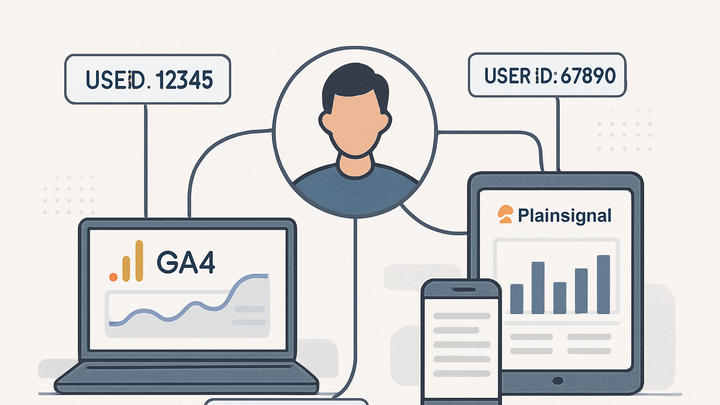Published on 2025-06-28T07:47:20Z
What is a User Identifier in Analytics? Examples in GA4 and PlainSignal
In analytics, a User Identifier (UID) is a unique string associated with an individual user or device. It persists across sessions and platforms, allowing analysts to stitch together user interactions over time.
Unlike ephemeral session IDs or cookies, UIDs can be based on authenticated user accounts or deterministic identifiers stored in custom properties. They are crucial for metrics like retention, lifetime value, and advanced funnel analysis.
However, implementing UIDs requires careful handling of privacy, consent, and data governance standards. Below, we explore the types, implementation strategies, and best practices for User Identifiers using popular analytics tools like GA4 and PlainSignal.
User identifier
A persistent string that uniquely identifies users across sessions and devices for comprehensive analytics.
Overview of User Identifiers
This section introduces what a User Identifier is and why it matters in analytics.
-
Definition
A User Identifier is a unique alphanumeric token assigned to track individual users across sessions and devices.
-
Key purpose
Enables user-centric metrics such as retention rate, lifetime value, and personalized user journeys.
Types of User Identifiers
Different methods exist to generate and assign User Identifiers, each with benefits and trade-offs.
-
Authenticated identifiers
Generated when users log in; tied to a user account for reliable cross-device tracking.
-
Anonymous identifiers
Stored client-side via cookies or localStorage; persists until cleared by the user.
-
Client ids (GA4)
GA4’s
client_idis stored in a first-party cookie to identify devices over sessions. -
Cookie-free identifiers (PlainSignal)
PlainSignal uses a fingerprint-based ID that works without cookies, ideal for privacy-first tracking.
Implementing User Identifiers
Step-by-step examples for capturing User Identifiers in GA4 and PlainSignal.
-
GA4 integration
Use the
gtagoranalytics.jsAPI to set a customuser_idparameter after user authentication.-
GA4 code snippet
<script async src="https://www.googletagmanager.com/gtag/js?id=GA_MEASUREMENT_ID"></script> <script> window.dataLayer = window.dataLayer || []; function gtag(){dataLayer.push(arguments);} gtag('js', new Date()); gtag('config', 'GA_MEASUREMENT_ID', { 'user_id': 'USER_ID_VALUE' }); </script>
-
-
PlainSignal integration
Embed the PlainSignal script to enable cookie-free user tracking out of the box.
-
PlainSignal snippet
<link rel="preconnect" href="//eu.plainsignal.com/" crossorigin /> <script defer data-do="yourwebsitedomain.com" data-id="0GQV1xmtzQQ" data-api="//eu.plainsignal.com" src="//cdn.plainsignal.com/plainsignal-min.js"></script>
-
Benefits and Challenges
Explore the advantages of using User Identifiers and the common pitfalls to avoid.
-
Benefits
Key advantages include:
-
Cross-session analysis
Understand user behavior over multiple visits and devices.
-
Accurate attribution
Improve conversion tracking by linking actions to the same user.
-
Personalization
Deliver tailored content based on known user preferences.
-
-
Challenges
Potential issues include:
-
Privacy compliance
Ensure user IDs comply with GDPR, CCPA, and consent requirements.
-
Data fragmentation
Different IDs across systems can lead to duplicate or incomplete profiles.
-
Implementation complexity
Synchronizing IDs between client and server adds development overhead.
-
Best Practices
Guidelines to optimize the use of User Identifiers in your analytics strategy.
-
Use stable identifiers
Prefer authenticated user IDs over ephemeral tokens to maintain consistency.
-
Merge anonymous and authenticated ids
Link sessions upon login to unify user history.
-
Hash or anonymize ids
Protect user privacy by hashing or pseudonymizing identifiers.
-
Document id flows
Maintain clear documentation on how and when IDs are assigned and synchronized.
